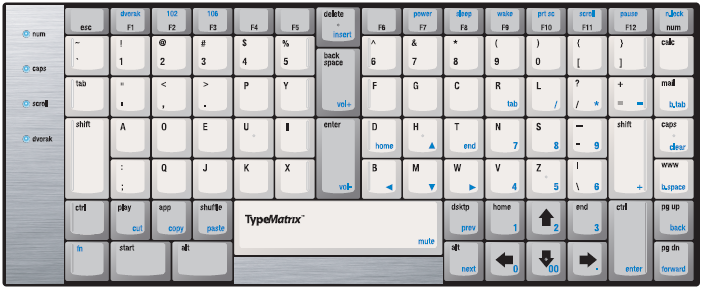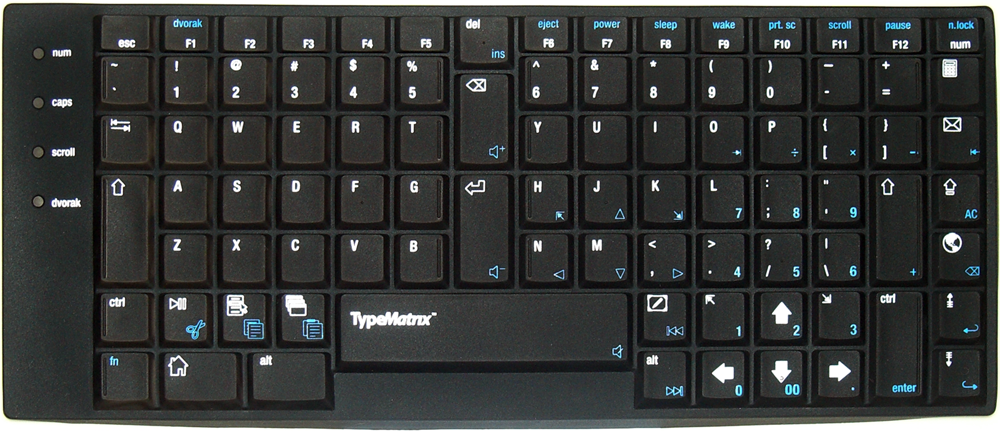TypeMatrix and DVORAK | | | Dvorak labeled 2030 USB | | |  | | | 2030 USB Keyboard skin - Black Dvorak (US English) |
The current QWERTY keyboard was designed in 1872 for two fingered "hunt
and peck" typists. But it became the standard and has survived to the
21st Century basically unchanged.
August Dvorak invented the Simplified Keyboard (as he called it) in
1932 as a result of exhaustive time and motion studies. The Dvorak Keyboard
(as the Simplified Keyboard is now known) has been only marginally necessary
until the widespread use of computers.
Now, Repetitive Stress Injuries (RSI) are a major factor for anyone
who spends even a few hours a day working with a keyboard. The Dvorak
Layout reduces finger movement by more than 50%, and hence is
"just what the doctor ordered" for those suffering RSI.
Users of the Dvorak Keyboard may be faster and make fewer errors
than an equally qualified QWERTY typist, but most importantly, stress
on the fingers, hands and wrists is greatly reduced . TypeMatrix EZ-Reach keyboards are ALL switchable to Dvorak without any software.
Here's more information about Dvorak:In the beginning... In 1872, when Christopher
Sholes invented the first practical typewriter, he was faced with a
serious problem: his typists constantly jammed their machines. They
were typing too fast. Because typewriting mechanisms were bulky and
heavy, those early machines were designed to be typed using only the
two index fingers, with what came to be known as the Columbus method.
The typist "discovered" the location of a key and hit that key with
the index finger. We now call this method Hunt and Peck. Sholes had
to solve this problem of jammed machines. His solution was the only
one available to him: he rearranged the keys to slow down the typists!
That keyboard layout is still in use today, 125 years later. We know
this keyboard layout as the QWERTY keyboard, named for the layout of
the keyboard's first six letters.
Touch typing (using all 10 fingers) started to catch on in the 1880s.
The QWERTY layout was the only layout then available, so it became the
standard. But QWERTY had serious problems, having never been designed
for touch typing. Even Sholes recognized this truth, and in 1889, he
was granted a patent for an improved layout. But the QWERTY keyboard
layout was firmly entrenched, and thus it remained the standard.
1930's - Dvorak creates simplified keyboard. As
the industrial revolution reached its zenith, time and motion studies
became all important. Reducing the time necessary and the motion required
to complete a specific task meant higher quality products, cheaper labor
costs and hence cheaper prices. In the early 1900s, researchers Frank
and Lillian Gilbreth made slow motion films of expert typists at work.
These films made their way to Professor August Dvorak via Dvorak's bother-in-law,
William Dealey. Both men immediately saw the problems inherent in the
QWERTY keyboard. Typist's speeds were limited and they made too many
mistakes. But more importantly, they became quickly fatigued, and they
suffered pain and soreness. Today we call these symptoms Repetitive
Stress Injury (RSI). Dvorak and Dealey set about to minimize these problems
and by 1932, had a keyboard layout that reduced finger movement an order
of magnitude (10 times). Furthermore, the Dvorak Simplified Keyboard
(as Dvorak called it) enhanced speed, and reduced errors. But the Depression
was at its deepest point, and nobody could afford to buy new typewriters.
Dvorak's layout had to wait.
During World War II, the Navy did in-depth studies, which showed without
any doubt, the Dvorak layout was vastly superior to the QWERTY layout.
But again, the standard layout was too standard. The Dvorak Layout was
set aside. By now, the name Dvorak Simplified Keyboard had evolved to
Dvorak.
In the early 1970s, interest in the Dvorak Layout once again came into
the public consciousness. Several magazines published articles dealing
with the advantages and improvements that the Dvorak Layout could offer.
Both the Saturday Review and Writer's Digest explored the subject in
considerable detail. The typewriter manufacturer Smith-Corona was convinced
that the Dvorak Layout's time had arrived and offered all of its typewriters
in either QWERTY or Dvorak. Smith-Corona charged only $5 for Dvorak
in its portable models, and no charge for the rest of its typewriter
line. But interest in the Dvorak Layout waned and died. Unfortunately,
in 1975, August Dvorak passed away leaving his goal of a widespread
simplified keyboard undone.
The computer Age... Enter the PC age and Apple
computer. The Apple IIe had the Dvorak layout inside, waiting. But Apple
did not tell anybody how make the "other" keyboard work. Then the Apple
IIc was introduced, with a QWERTY/Dvorak switch right there in front
where everybody could see and use it. Most buyers of the IIc were vaguely
aware of the QWERTY/Dvorak switch, but without an explanation of the
Dvorak option, most people ignored Dvorak. Even Microsoft had the Dvorak
keyboard available to its customers, but prior to the first version
of Windows, the keyboard mapping within the computer had to be modified
during the boot-up process. When Windows came on the scene, some Apple
computer alumni brought with them the idea of multiple keyboards to
Microsoft, and as a result, Dvorak, along with many other international
keyboard layouts is available through Windows: Settings - Control Panel
- Keyboard - Language - Properties. There are even Dvorak layouts for
one-handed typists, left or right.
The disadvantage of Windows layout translation is that it is dependent
on the Operating System, in this case, Windows. Thus, leaving Windows
also leaves behind Dvorak. This is particularly troublesome if one uses
MS-DOS or Linux. With the DvortyBoard and the TypeMatrix keyboards,
the keyboard in use becomes invisible to the computer and the operating
system it is using. The user has the option of switching the keyboard
layout at any time.
LEARNING DVORAKThe learning curve is not particularly steep. Any typist of any reasonable
ability probably spent most of a year in high school or college reaching
a speed of 40 words per minute with an acceptable error rate. But much
of that learning was not just key location. A new typist must learn
hand position, finger movement and force, and rhythm (beginning typing
classes type to music). Good typists type letter combinations, not just
individual letters. Much of this typing is automatic: thinking of a
word, with the fingers then hitting the proper keys, in the proper sequence.
This concept is sometimes referred to as "muscle memory". Although the
term is a misnomer, the concept is solid.
So, regardless of what keyboard layout you have initially learned, a
large portion of that initial education transfers to another keyboard
layout. An accomplished QWERTY typist will take, on average, about 100
hours to make the transition. This includes productivity lost in early
training and productivity later regained as proficiency is obtained.
Once the transition is made, the Dvorak typist will usually type
faster, with a lower error rate and with reduced fatigue and injury.
If you type up to several hours per day, your total transition time
will be less. Learning the Dvorak Layout is dependent more on learning
key location than how to type. Thus, remembering where the keys are
located is what takes the time. Short, daily practice sessions will
minimize the transition time. Some touch-typists have learned Dvorak
in 25 hours. Being a poor QWERTY touch-typist may be an advantage. Barbara
Blackburn failed her High School Typing class. She switched to the Dvorak
Keyboard 60 years ago, and was the world's fastest typist at over 200
words per minute! Now in her 80's, she still types 160+ wpm. The downside
to learning Dvorak is that QWERTY must be suppressed. There is a difficult
time during the transition in which both sets of keyboard layouts are
held in the brain, and may be confused while typing. Practice and commitment
will overcome this temporary confusion. Some typists are able to maintain
accuracy in both layouts, but we do not recommend that this be an expected
outcome.
Considerable data, collected by Dvorak, shows that a new typist learning
the Dvorak layout, will learn that layout much faster than a new typist
learning the Qwerty layout. The Navy investigated the Dvorak layout
for this reason. They needed more and faster typists. But bureaucratic
inertia prevented Dvorak from being adopted.
TypeMatrix knows that change of this magnitude is not always practical.
Nor is the changing of the keyboard layout through the Windows interface
particularly convenient. QWERTY has been the long time standard, and
many proficient as well as occasional typists are understandably reluctant
to change what they already know. But standard is not always better.
If you are experiencing pain or fatigue, have RSI as a result of
typing, or would like to increase your speed and accuracy, the Dvorak
keyboard is for you. And with TypeMatrix EZ-Reach keyboards, you can have
the best of both worlds, at the same time. The keyboards
allow you to make the change by pressing and holding the "Function" key and
tapping the "Dvorak" key. As an added bonus, your computer will not know or care which keyboard
layout you are using. All of our keyboard models currently have a Standard
PS/2 connector and we include a free USB adapter/converter that allows the
keyboard to also work with Mac and SUN systems (For maximum compatibility with Mac
systems we recommend purchasing the Belkin USB adapter - available on the order page).
Your computer will think it is connected to any standard
keyboard, but you can type using QWERTY or Dvorak.
A few videos about Dvorak from ExpertVilage.com |